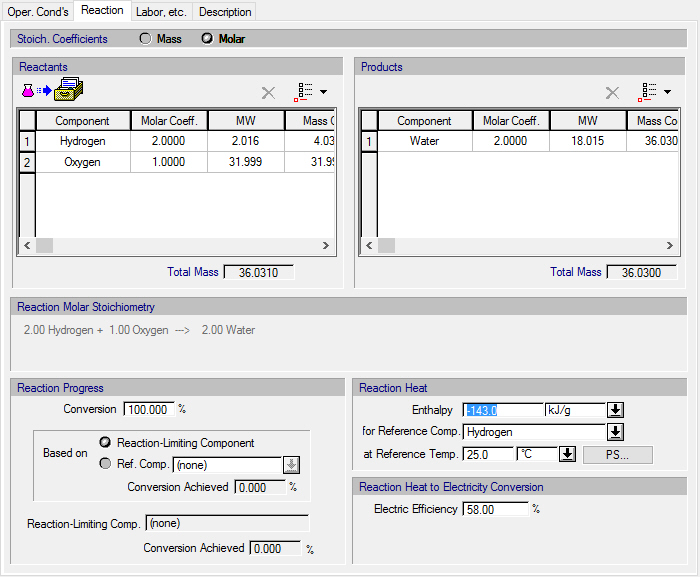

The following table shows a brief description of the variables appearing in this tab. The table also displays their default values and their generally acceptable range:
|
Variable |
Default Value |
Range |
|
|
||
|
◙ Molar Coeff. of Reactant |
1.0 |
Positive |
|
◙ MW of Reactant |
MW |
Positive |
|
◙ Mass Coeff. of Reactant |
MW |
Positive |
|
● Total Mass of Reactants |
0.0 |
Positive |
|
◙ Molar Coeff. of Product |
1.0 |
Positive |
|
◙ MW of Product |
MW |
Positive |
|
◙ Mass Coeff. of Product |
MW |
Positive |
|
● Total Mass of Product |
0.0 |
Positive |
|
○ Reaction Extent (%) |
100.0 |
0-100 |
|
○ Ref. Comp. |
<none> |
Any Pure Component |
|
● Extent Achieved (of Ref. Comp.) (%) |
0.0 |
0-100 |
|
● Reaction-Limiting Comp. |
<none> |
Any Pure Component |
|
● Extent Achieved (of Reaction-Limiting Comp.) (%) |
0.0 |
0-100 |
|
○ Enthalpy (kcal/kg) |
0.0 |
Negative or Zero |
|
○ Reference Component |
<none> |
Any Pure Component |
|
○ Reference Temp. (oC) |
25.0 |
Positive |
|
○ Electric Efficiency (%) |
40.0 |
0-100 |
Symbol Key: ○ User-specified value (always input); ● Calculated value (always output); ◙ Sometimes input, sometimes output
Through this interface you can specify the stoichiometry, progress and heat of an (exothermic) electro-chemical reaction. The following list describes the available specification choices in this tab; for more details on how these are implemented, see Power Generation in a Fuel Cell: Modeling Calculations.
•Register Pure Components
It is possible to introduce new pure components in the process by simply clicking on this button: 
This will present you with the Pure Component Registration Dialog that allows you to register new pure components without exiting the stoichiometry balance and the operating conditions dialogs.
•Adding/Deleting Reactants and Products...
Clicking on the  button of the Reactants / Products frame displays a list of available reactants / products that can be added to the reaction. Select a component in order to add it as a reactant / product. You can alter the mass/molar stoichiometric coefficient of a reactant/product through the respective table. Note that if a component is used as a reactant it can not be used as a product and vice versa. To delete a reactant or a product, first select it by clicking on the corresponding row number, and then click on the
button of the Reactants / Products frame displays a list of available reactants / products that can be added to the reaction. Select a component in order to add it as a reactant / product. You can alter the mass/molar stoichiometric coefficient of a reactant/product through the respective table. Note that if a component is used as a reactant it can not be used as a product and vice versa. To delete a reactant or a product, first select it by clicking on the corresponding row number, and then click on the  button.
button.
•Stoichiometric Coefficients...
You may choose to specify either mass coefficients or molar coefficients. Use positive coefficients for both products and reactants. Note that the “Molar Coeff.” and “MW” columns are displayed only if the molar option is chosen for the reaction stoichiometry (instead of the mass). The total mass of products and reactants is displayed below each table. The total mass of reactants must be equal to the total mass of products.
•Reaction Extent...
It represents the fractional conversion of the limiting or reference component. Note that if the specified reaction extent based on a reference component is not feasible, the program will use the maximum possible reaction extent (corresponding to extent of 0 or 100%). The extent achieved is displayed in the dialog.
•Reaction Enthalpy...
The reaction enthalpy of an electrochemical reaction must be negative to indicate that this reaction is exothermic (heat releasing).
•Assumed Physical States (PS) of Reaction Participants
Click the ‘PS...’ button to display the “Assumed PS of Participants in Reaction” dialog for the specified reaction. SuperPro offers the option to specify the physical states of the reaction participants (at the specified reference temperature) that correspond to the specified reaction enthalpy. By default, the physical states of the participating components are inferred by the normal boiling point criterion at the reaction reference temperature.